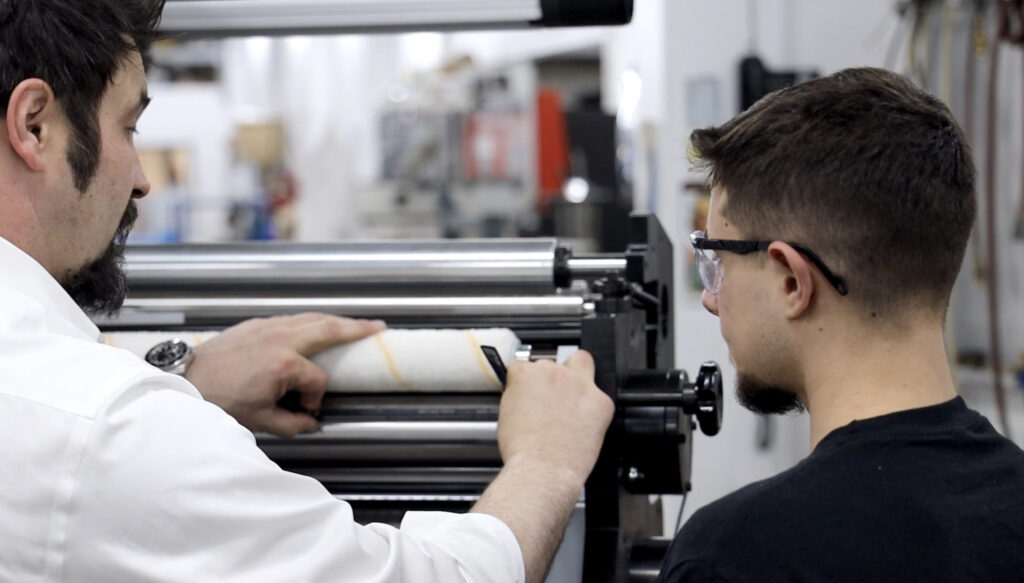Die cutting is an important part of many web finishing processes, where various types of materials must be cut and affixed to packaging products, boxes, labels, or forms. The method of die cutting that best suits your application will depend on a few different factors, such as whether or not the job requires high volume and/or high precision.
There are basically three different methods of die cutting:
- Flatbed
- Rotary
- Laser
Each method creates pieces that are identical in shape and size with different die-cutting techniques. Each die-cutting method offers different advantages and disadvantages depending on the scope of the project.
Flatbed Die Cutting
Flatbed die cutting is the most basic and traditional method used for die cutting material and involves the use of a hydraulic press and a fabricated cutting die, or tool that cuts through the material to consistently cut the same shape. Flatbed die cutting is efficient and provides the force to cleanly cut through thick, sheeted materials. Flatbed die cutting is used to stamp out repeated shapes like a cookie-cutter. Tools can be changed on the flatbed press when it’s time to change the die-cutting shape.
Rotary Die Cutting
A rotary die cutting process utilizes a cylindrical die that cuts shapes out as it moves in a circular motion. Rotary die cutting presses provide tight tolerance for precision cuts utilizing servo motors for accurate registration. This method of die cutting provides advantages when high volumes are required and especially when cutting through thick materials. Rotary die cutting is efficient and accurate and provides advantages in many fields, such as aerospace and medical applications.
Laser Die Cutting
Laser die cutting, as the name implies, uses a laser light beam instead of a steel mold or blades to cut the desired shape. Laser die cutting can provide advantages and processes that require extremely small details, precision cutting, and minimal contact with materials. Laser die cutting is highly repeatable for consistent quality when precision, repeatable cuts are required and is often chosen when cutting on flexible materials such as laminate, rubber, and tapes or when using materials or adhesives that would be damaged by traditional die cutting processes.
Consider Your Process Requirements
While each method provides advantages, depending on the most important priorities for your application, one method of die cutting may be better than another.
Speed
Laser die cutting provides precision but is not the fastest method when compared to Rotary die cutting.
Cleanliness
Laser cutting must burn through the material and therefore is not necessarily the cleanest method of cutting, although it makes sense in some applications such as cutting out pieces of sandpaper, for example, that would be damaged from a steel blade more so than laser cutting. When looking for the cleanest method, flatbed or rotary die cutting provides advantages over lasers, which can leave residue on the edges when searing through material.
Deep or Multilayer Cuts
When die cutting requires going through thick material or multilayers, flatbed or rotary can provide the best performance. Laser die cutting is typically set for one depth of cut and not multiple layers.
Low Maintenance
Because flatbed and rotary die cutting use mechanical equipment, refurbishing may be required to sharpen steel blades. Laser die cutting operates from a computerized program making downtime for maintenance a nonissue.
Choosing the right die-cutting process for your application depends on the method that will provide the best quality at the most efficient operation. When you need web finishing equipment such as for producing integrated labels or inlays, Tamarack® Products offers precision, quality equipment built to last and expert technical guidance for a quality, efficient process.
Tamarack® Products is an industry-leading manufacturer of high-quality, specialized equipment used in packaging, forms, and integrated label industries. We differ from other equipment suppliers in our high-tech expertise, value-added services, and commitment to our customers’ total success. Contact us with any questions and to learn more about choosing the best die-cutting method for your web finishing application.





